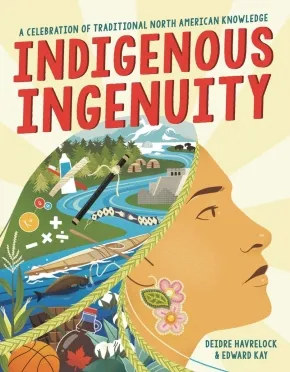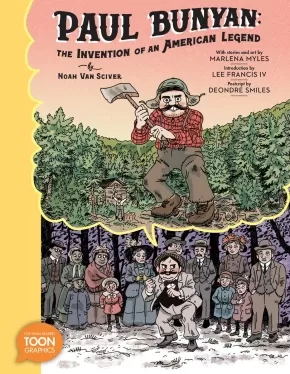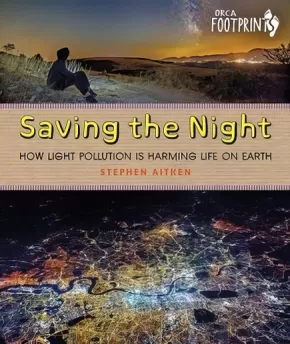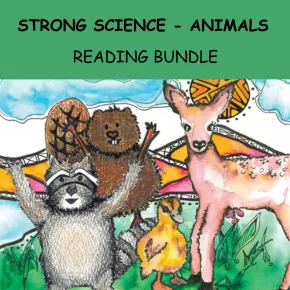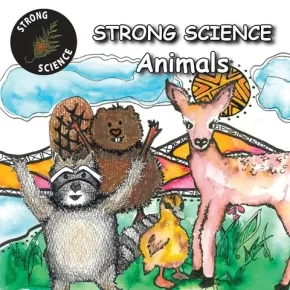
Environmental Awareness
31
-
45
of
130 Results;
Sort By
Go To
of 9
Indigenous Ingenuity: A Celebration of Traditional North American Knowledge (PB)
$12.99
Artists:
Format:
Paperback
ISBN / Barcode: 9780316413435
Synopsis:
Synopsis:
Celebrate Indigenous thinkers and inventions with this beautifully designed, award-winning interactive nonfiction book—perfect for fans of Braiding Sweetgrass.
Corn. Chocolate. Fishing hooks. Boats that float. Insulated double-walled construction. Recorded history and folklore. Life-saving disinfectant. Forest fire management. Our lives would be unrecognizable without these, and countless other, scientific discoveries and technological inventions from Indigenous North Americans.
Spanning topics from transportation to civil engineering, hunting technologies, astronomy, brain surgery, architecture, and agriculture, Indigenous Ingenuity is a wide-ranging STEM offering that answers the call for Indigenous nonfiction by reappropriating hidden history. The book includes fun, simple activities and experiments that kids can do to better understand and enjoy the principles used by Indigenous inventors. Readers of all ages are invited to celebrate traditional North American Indigenous innovation, and to embrace the mindset of reciprocity, environmental responsibility, and the interconnectedness of all life.
Reviews
"An astonishing, exuberant treasure trove of history, science and hands-on activities that repeatedly begs the question: "Why didn't I know this?" Essential for kids and adults. We need this book." —Candace Fleming, award-winning author of The Rise and Fall of Charles Lindbergh and The Family Romanov
"This book will amaze readers and teachers as it demonstrates how pervasive and critical the history of Indigenous people is. A completely unique and important narrative not to be missed; readers and teachers will come away with a new appreciation for the myriad contributions Indigenous people have made."—SLJ, starred review
"A conversational tone invites readers to engage with this monumental collection . . . Curious readers will learn facts unique to individual tribal groups while gaining knowledge of STEM/STEAM concepts. An ambitious, appealing, and accessible work documenting and protecting valuable knowledge."—Kirkus Reviews
"Engaging and informative, this will be welcomed by both STEM and social studies curricula to help to correct prevailing narratives about Indigenous technology."—Booklist, starred review
"Via authoritative, meticulously researched prose, the creators detail Native peoples’ significant strides in scientific pursuits . . . [and] showcase Native tribes’ continual and enduring impact. Photographs, as well as interactive activities detailing recipes and science experiments, feature throughout, lending a hands-on approach to this clear and concise work."—Publishers Weekly
"This book is a valuable contribution to efforts to decolonize learning and introduce readers to the breadth of indigenous knowledge as practiced in widely disparate geographic zones."—Canadian Review of Materials
"An engaging and cleverly compiled guide to North American and Mesoamerican Indigenous innovation. STEM topics (housing, medicine, clothing, agriculture, and hunting among them) are compellingly and conversationally discussed."—Shelf Awareness
Educator Information
Recommended for ages 8 to 12.
Fountas & Pinnell Text Level Gradient: Z
Additional Information
288 pages | 6.95" x 9.00" | Paperback
Less Is More: Join the Low-Waste Movement
$21.95
Format:
Hardcover
ISBN / Barcode: 9781459835443
Synopsis:
Synopsis:
All over the world, people are joining the low-waste movement and getting tough on their trash.
Maybe you’ve heard the reports of the Great Pacific Garbage Patch swirling in the ocean. Maybe you’ve seen the photos of whales and sea birds with trash in their bellies. Or maybe you’ve heard that only 9 percent of our plastic waste actually gets recycled.
We can all do our part for the planet by creating less garbage. In Less Is More young readers will discover how to avoid waste in the first place, reduce how much they use and reuse what they can, before they recycle and rot (compost) the rest. With small, simple actions we can become part of the circular economy. Find out how you can join the low-waste movement—and get your friends and family on board too!
Educator & Series Information
Recommended for ages 9 to 12.
This book is part of the Orca Footprint series.
Additional Information
48 pages | 8.00" x 9.50" | 51 Colour Photos, 3 Colour Tables, 2 Diagrams, 1 Index, 1 Bibliography | Hardcover
Paul Bunyan: The Invention of an American Legend
$15.99
Artists:
Format:
Paperback
Text Content Territories:
Indigenous American;
ISBN / Barcode: 9781662665233
Synopsis:
Synopsis:
Did you know that a mainstay of American folk culture was in fact created as an advertising ploy?
Few people realize that Paul Bunyan, the legendary lumberjack, and his blue ox are the product of corporate marketing by a highly industrialized commercial enterprise.
Cartoonist Noah Van Sciver shows us the myth creation as real-life marketing man extraordinaire W.B. Laughead spins ever more wondrous tall tales. Van Sciver's story is bracketed by rich contributions from contemporary Native artists and storytellers with a very different connection to the land that the Bunyan myths often conceal. Readers will see how a lumberjack hero, a quintessential American fantasy, captures the imagination but also serves to paper over the seizure of homeland from First Peoples and the laying bare of America's northern forests. It’s a tall tale with deep roots . . . in profit-making!
Reviews
"The Paul Bunyan tall tale gets felled. . . Readers will come away ready to question what other falsehoods they’ve been fed about the history of marginalized people. . . A heightened sense of scale makes Bunyan practically leap of the page in grandeur. An accessible and important reminder of how easily the truth can be coopted." -- Kirkus Reviews, STARRED
"Enlightening. . . . [A] frank and accessible depiction of the environmental and economic impact of boom-bust industries . . . and how the Bunyan fiction perpetuated these systems." —Publishers Weekly
"The combined cartoon and folk art styles work well to capture the giant lore of Paul Bunyan . . . A mighty attempt to take on a giant topic of forgotten history".--Booklist
“A fast-paced and enjoyable book that captures the cadence and evolution of tall tales in oral history. The bookend contributions by Native authors provide a nuanced and essential critical exploration of the impact of American logging on Native American land.”—SHING YIN KHOR, author of The Legend of Auntie Po, a National Book Award Finalist
"Logging culture may have produced some great stories. But it also cost America, and especially the indigenous people whose land all those trees once stood on, greatly. Both facts are important parts of our history. Van Sciver’s Paul Bunyan tells them both, and he does so in a way that is both potent and fun." – SLJ's Good Comics For Kids
Educator Information
Recommended for ages 7+
Additional Information
48 pages | 7.75" x 10.00" | Paperback
Saving the Night: How Light Pollution Is Harming Life on Earth
$21.95
Format:
Hardcover
ISBN / Barcode: 9781459831070
Synopsis:
Synopsis:
Light pollution threatens the survival of every living species on our planet, including people.
It started when Thomas Edison invented the first light bulb more than 150 years ago. Then, as electric light became more common, light pollution began to take over cities and towns. Today, in urban centers all over the world, the stars in the sky aren't visible. Millions of people have never seen the Milky Way. In Saving the Night, we discover how plants and animals have adapted over millions of years to survive and thrive in the dark, and how artificial light can upset the balance of entire ecosystems. But there are ways we can take back the night for animals, plants and us. It starts with the flick of a switch.
Reviews
“Richly described and alluring…Aitken urges his readers to be unafraid of the dark and after reading this excellent book, tweens will want to venture forth into the night without a flashlight.”— School Library Journal
“Both personal and poetic…A very comprehensive look at the role of light in the natural world and the effect of light pollution on all living organisms. This book deserves to be available and promoted in schools and libraries. Saving the night for all of us is worth it. Highly Recommended.” — CM: Canadian Review of Materials
“[An] informative addition to the Footprints series…This organized, involving book will fill a gap in many library collections.”— Booklist
“Flashes on a too often unconsidered sort of environmental pollution.”— Kirkus Reviews
Educator & Series Information
This book is part of the Orca Footprint series. Kids today inhabit a world full of complex—and often mystifying—environmental issues. Orca Footprints aim to help kids answer their questions about the state of the natural world with well-researched, simply-expressed information and powerful images. With topics such as food production, water, cycling and sustainable energy, these books will inspire kids to take action.
Recommended for ages 9-12.
Additional Information
48 pages | 8.00" x 9.50" | Hardcover
Stand as Tall as the Trees: How an Amazonian Community Protected the Rain Forest
$21.99
Artists:
Format:
Hardcover
Text Content Territories:
Indigenous South American; Indigenous Peoples in Ecuador; Kichwa (Quichua);
ISBN / Barcode: 9781623542368
Synopsis:
Synopsis:
An inspiring true story about how an activist in the Amazon worked with other Indigenous communities to protect and preserve their sacred lands and forests.
Patricia (Paty) Gualinga grew up in her Kichwa village in the Amazon of Ecuador where mystical beings called Amazanga help protect the forest. Paty traveled away from home for school until she was called back—companies that said the government sold them property were destroying her people’s lands to look for oil. The Kichwa community worked with other Indigenous groups to bring the Ecuadorian government to the Court of Human Rights.
Lyrically told and beautifully illustrated, this moving story will remind readers of the importance of nature conservation, perseverance, and standing up for your community.
Educator Information
Recommended for ages 6 to 9.
Additional Information
40 pages | 7.87" x 11.00" | Hardcover
Strong Science - Animals Reading Bundle
$648.00 $720.00
Text Content Territories:
Indigenous Canadian;
Grade Levels: Kindergarten; 1;
ISBN / Barcode: 9781771746267
Synopsis:
Synopsis:
This bundle includes six copies of each of the 16 titles in the Strong Science - Animals series (96 books total).
Series Information
Strong Science - Animals is a language-based science series for primary students featuring animals that all Canadian students will recognize. Photographs and Indigenous artwork illustrate the series. Common learning objectives in science curricula across Canada are addressed, and suggestions for extending the learning to other curriculum areas, including Indigenous cultural awareness, language arts, math, and art, are included in the teacher’s guide. The sixteen books in this series are grouped into four levels that increase in complexity, designed to accommodate students with various reading abilities within a classroom. This feature facilitates the use of this series in literacy programs along with the Strong Readers series.
This series works best as a unit with the teacher's guide: Strong Science - Animals Teacher's Guide. The series is recommended for use in a grade 1 classroom, but may also be useful for kindergarten students.
Books in this series are divided into four levels: Early Primary 1 (EP1); Early Primary 2 (EP2); Early Primary 3 (EP3); Early Primary 4 (EP4). Font size decreases as language complexity and word count increase across levels: EP1 books have approximately 40 words, EP2 books have approximately 60 words, EP3 books have approximately 80 words, and EP4 books have approximately 100 words.
Authenticity Note: In the series, titles by author Kim Soo Goodtrack have received the Indigenous Text label because she is Indigenous (Lakota) and the featured animal in each story holds cultural significance in many Indigenous cultures. The engaging stories provide factual information in an easy-to-read format for children to learn science concepts and build literacy skills. They promote respect for animals and Mother Earth, and their illustrations communicate additional cultural information through Lakota symbolism and designs. Further cultural connections are identified in the teacher's guide. Refer to the guide to explore the books' Indigenous connections fully.
Series Authors: Brenda Boreham and Kim Soo Goodtrack
Series Illustrator: Kim Soo Goodtrack
Additional Information
Each book is 16 Pages | Each book is 6.5" x 5.5" | Paperback | ISBN: 9781771746267
Strong Science - Animals Single Set Bundle
 $108.00 $120.00
$108.00 $120.00

Text Content Territories:
Indigenous Canadian;
Grade Levels: Kindergarten; 1;
ISBN / Barcode: 9781771746250
Synopsis:
Synopsis:
This bundle includes one copy of each of the 16 titles in the Strong Science - Animals series (16 books total).
Series Information
Strong Science - Animals is a language-based science series for primary students featuring animals that all Canadian students will recognize. Photographs and Indigenous artwork illustrate the series. Common learning objectives in science curricula across Canada are addressed, and suggestions for extending the learning to other curriculum areas, including Indigenous cultural awareness, language arts, math, and art, are included in the teacher’s guide. The sixteen books in this series are grouped into four levels that increase in complexity, designed to accommodate students with various reading abilities within a classroom. This feature facilitates the use of this series in literacy programs along with the Strong Readers series.
This series works best as a unit with the teacher's guide: Strong Science - Animals Teacher's Guide. The series is recommended for use in a grade 1 classroom, but may also be useful for kindergarten students.
Books in this series are divided into four levels: Early Primary 1 (EP1); Early Primary 2 (EP2); Early Primary 3 (EP3); Early Primary 4 (EP4). Font size decreases as language complexity and word count increase across levels: EP1 books have approximately 40 words, EP2 books have approximately 60 words, EP3 books have approximately 80 words, and EP4 books have approximately 100 words.
Authenticity Note: In the series, titles by author Kim Soo Goodtrack have received the Indigenous Text label because she is Indigenous (Lakota) and the featured animal in each story holds cultural significance in many Indigenous cultures. The engaging stories provide factual information in an easy-to-read format for children to learn science concepts and build literacy skills. They promote respect for animals and Mother Earth, and their illustrations communicate additional cultural information through Lakota symbolism and designs. Further cultural connections are identified in the teacher's guide. Refer to the guide to explore the books' Indigenous connections fully.
Series Authors: Brenda Boreham and Kim Soo Goodtrack
Series Illustrator: Kim Soo Goodtrack
Additional Information
Each book is 16 Pages | Each book is 6.5" x 5.5" | Paperback | ISBN 9781771746250
Strong Science - Animals: A Beaver Family
 $7.50
$7.50

Format:
Paperback
Grade Levels: Kindergarten; 1;
ISBN / Barcode: 9781771746069
Synopsis:
Synopsis:
This book is about a beaver family.
Beavers work together to make their homes and to find food.
Have you seen beavers working in a lake, pond, or marsh?
Educator & Series Information
Recommended for grade 1 students, but may also be useful in kindergarten classrooms.
Strong Science - Animals is a language-based science series for primary students featuring animals that all Canadian students will recognize. Photographs and Indigenous artwork illustrate the series. Common learning objectives in science curricula across Canada are addressed, and suggestions for extending the learning to other curriculum areas, including Indigenous cultural awareness, language arts, math, and art, are included in the teacher’s guide. The sixteen books in this series are grouped into four levels that increase in complexity, designed to accommodate students with various reading abilities within a classroom. This feature facilitates the use of this series in literacy programs along with the Strong Readers series.
A Beaver Family is an EP2 (Early Primary 2) book in the Strong Science - Animals series. Font size decreases as language complexity and word count increase across levels: EP1 books have approximately 40 words, EP2 books have approximately 60 words, EP3 books have approximately 80 words, and EP4 books have approximately 100 words.
A teacher's guide for Strong Science - Animals is available: Strong Science - Animals: Teacher's Guide
Additional Information
16 Pages | 6.5" x 5.5" | Paperback | ISBN: 9781771746069
Strong Science - Animals: A Deer Family
 $7.50
$7.50

Format:
Paperback
Grade Levels: Kindergarten; 1;
ISBN / Barcode: 9781771746076
Synopsis:
Synopsis:
This book is about a black-tailed deer family.
Black-tailed deer live at the edge of the forest.
Have you seen deer in a park, field, or forest?
Educator & Series Information
Recommended for grade 1 students, but may also be useful in kindergarten classrooms.
Strong Science - Animals is a language-based science series for primary students featuring animals that all Canadian students will recognize. Photographs and Indigenous artwork illustrate the series. Common learning objectives in science curricula across Canada are addressed, and suggestions for extending the learning to other curriculum areas, including Indigenous cultural awareness, language arts, math, and art, are included in the teacher’s guide. The sixteen books in this series are grouped into four levels that increase in complexity, designed to accommodate students with various reading abilities within a classroom. This feature facilitates the use of this series in literacy programs along with the Strong Readers series.
A Deer Family is an EP2 (Early Primary 2) book in the Strong Science - Animals series. Font size decreases as language complexity and word count increase across levels: EP1 books have approximately 40 words, EP2 books have approximately 60 words, EP3 books have approximately 80 words, and EP4 books have approximately 100 words.
A teacher's guide for Strong Science - Animals is available: Strong Science - Animals: Teacher's Guide
Additional Information
16 Pages | 6.5" x 5.5" | Paperback | ISBN: 9781771746076
Strong Science - Animals: A Duck Family
 $7.50
$7.50

Format:
Paperback
Grade Levels: Kindergarten; 1;
ISBN / Barcode: 9781771746106
Synopsis:
Synopsis:
This book is about a mallard duck family.
Mallards live near water.
Have you seen mallards in a marsh, pond, or lake?
Educator & Series Information
Recommended for grade 1 students, but may also be useful in kindergarten classrooms.
Strong Science - Animals is a language-based science series for primary students featuring animals that all Canadian students will recognize. Photographs and Indigenous artwork illustrate the series. Common learning objectives in science curricula across Canada are addressed, and suggestions for extending the learning to other curriculum areas, including Indigenous cultural awareness, language arts, math, and art, are included in the teacher’s guide. The sixteen books in this series are grouped into four levels that increase in complexity, designed to accommodate students with various reading abilities within a classroom. This feature facilitates the use of this series in literacy programs along with the Strong Readers series.
A Duck Family is an EP2 (Early Primary 2) book in the Strong Science - Animals series. Font size decreases as language complexity and word count increase across levels: EP1 books have approximately 40 words, EP2 books have approximately 60 words, EP3 books have approximately 80 words, and EP4 books have approximately 100 words.
A teacher's guide for Strong Science - Animals is available: Strong Science - Animals: Teacher's Guide
Additional Information
16 Pages | 6.5" x 5.5" | Paperback | ISBN: 9781771746106
Strong Science - Animals: A Home for the Beavers
 $7.50
$7.50

Artists:
Format:
Paperback
Text Content Territories:
Indigenous Canadian;
Grade Levels: Kindergarten; 1;
ISBN / Barcode: 9781771746120
Synopsis:
Synopsis:
This story is about a beaver home.
Beavers make homes out of sticks, rocks, and mud.
There are four seasons in the year: winter, spring, summer, and fall. Which season is this story about?
Educator & Series Information
Recommended for grade 1 students, but may also be useful in kindergarten classrooms.
Strong Science - Animals is a language-based science series for primary students featuring animals that all Canadian students will recognize. Photographs and Indigenous artwork illustrate the series. Common learning objectives in science curricula across Canada are addressed, and suggestions for extending the learning to other curriculum areas, including Indigenous cultural awareness, language arts, math, and art, are included in the teacher’s guide. The sixteen books in this series are grouped into four levels that increase in complexity, designed to accommodate students with various reading abilities within a classroom. This feature facilitates the use of this series in literacy programs along with the Strong Readers series.
A Home for the Beavers is an EP3 (Early Primary 3) book in the Strong Science - Animals series. Font size decreases as language complexity and word count increase across levels: EP1 books have approximately 40 words, EP2 books have approximately 60 words, EP3 books have approximately 80 words, and EP4 books have approximately 100 words.
A teacher's guide for Strong Science - Animals is available: Strong Science - Animals: Teacher's Guide
Authenticity Note: This book has received the Indigenous Text label because the author is Indigenous (Lakota) and the featured animal holds cultural significance in many Indigenous cultures. The engaging story provides factual information in an easy-to-read format for children to learn science concepts and build literacy skills. It promotes respect for animals and Mother Earth, and its illustrations communicate additional cultural information through Lakota symbolism and designs. Further cultural connections are identified in the teacher's guide. Refer to the guide to explore the book's Indigenous connections fully. It is up to readers to determine if the book will work as a stand-alone authentic Indigenous text for their purposes.
Additional Information
16 Pages | 6.5" x 5.5" | Paperback | ISBN: 9781771746120
Strong Science - Animals: A Raccoon Family
 $7.50
$7.50

Format:
Paperback
Grade Levels: Kindergarten; 1;
ISBN / Barcode: 9781771746113
Synopsis:
Synopsis:
This book is about a raccoon family.
Raccoon families live where they can find food.
Have you seen raccoons on a beach, in a city, or in a park?
Educator & Series Information
Recommended for grade 1 students, but may also be useful in kindergarten classrooms.
Strong Science - Animals is a language-based science series for primary students featuring animals that all Canadian students will recognize. Photographs and Indigenous artwork illustrate the series. Common learning objectives in science curricula across Canada are addressed, and suggestions for extending the learning to other curriculum areas, including Indigenous cultural awareness, language arts, math, and art, are included in the teacher’s guide. The sixteen books in this series are grouped into four levels that increase in complexity, designed to accommodate students with various reading abilities within a classroom. This feature facilitates the use of this series in literacy programs along with the Strong Readers series.
A Raccoon Family is an EP2 (Early Primary 2) book in the Strong Science - Animals series. Font size decreases as language complexity and word count increase across levels: EP1 books have approximately 40 words, EP2 books have approximately 60 words, EP3 books have approximately 80 words, and EP4 books have approximately 100 words.
A teacher's guide for Strong Science - Animals is available: Strong Science - Animals: Teacher's Guide
Additional Information
16 Pages | 6.5" x 5.5" | Paperback | ISBN: 9781771746113
Strong Science - Animals: All About Beavers
 $7.50
$7.50

Format:
Paperback
Grade Levels: Kindergarten; 1;
ISBN / Barcode: 9781771746182
Synopsis:
Synopsis:
This book is about beavers.
Beavers have two layers of thick fur to keep them warm in the water. They have wide, flat tails. Their tails help them balance when they cut down trees.
What else do you know about beavers?
Educator & Series Information
Recommended for grade 1 students, but may also be useful in kindergarten classrooms.
Strong Science - Animals is a language-based science series for primary students featuring animals that all Canadian students will recognize. Photographs and Indigenous artwork illustrate the series. Common learning objectives in science curricula across Canada are addressed, and suggestions for extending the learning to other curriculum areas, including Indigenous cultural awareness, language arts, math, and art, are included in the teacher’s guide. The sixteen books in this series are grouped into four levels that increase in complexity, designed to accommodate students with various reading abilities within a classroom. This feature facilitates the use of this series in literacy programs along with the Strong Readers series.
All About Beavers is an EP4 (Early Primary 4) book in the Strong Science - Animals series. Font size decreases as language complexity and word count increase across levels: EP1 books have approximately 40 words, EP2 books have approximately 60 words, EP3 books have approximately 80 words, and EP4 books have approximately 100 words.
A teacher's guide for Strong Science - Animals is available: Strong Science - Animals: Teacher's Guide
Additional Information
16 Pages | 6.5" x 5.5" | Paperback | ISBN: 9781771746182
Strong Science - Animals: All About Deer
 $7.50
$7.50

Format:
Paperback
Grade Levels: Kindergarten; 1;
ISBN / Barcode: 9781771746144
Synopsis:
Synopsis:
There are many kinds of deer. The deer in this book are black-tailed deer.
Black-tailed deer have light brown coats in the summer. They grow thicker, darker coats in the winter.
Educator & Series Information
Recommended for grade 1 students, but may also be useful in kindergarten classrooms.
Strong Science - Animals is a language-based science series for primary students featuring animals that all Canadian students will recognize. Photographs and Indigenous artwork illustrate the series. Common learning objectives in science curricula across Canada are addressed, and suggestions for extending the learning to other curriculum areas, including Indigenous cultural awareness, language arts, math, and art, are included in the teacher’s guide. The sixteen books in this series are grouped into four levels that increase in complexity, designed to accommodate students with various reading abilities within a classroom. This feature facilitates the use of this series in literacy programs along with the Strong Readers series.
All About Deer is an EP4 (Early Primary 4) book in the Strong Science - Animals series. Font size decreases as language complexity and word count increase across levels: EP1 books have approximately 40 words, EP2 books have approximately 60 words, EP3 books have approximately 80 words, and EP4 books have approximately 100 words.
A teacher's guide for Strong Science - Animals is available: Strong Science - Animals: Teacher's Guide
Additional Information
16 Pages | 6.5" x 5.5" | Paperback | ISBN: 9781771746144
Strong Science - Animals: All About Ducks
 $7.50
$7.50

Format:
Paperback
Grade Levels: Kindergarten; 1;
ISBN / Barcode: 9781771746151
Synopsis:
Synopsis:
There are many kinds of ducks.
The ducks in this book are mallards.
Ducks can swim, walk, and fly.
What else do you know about ducks?
Educator & Series Information
Recommended for grade 1 students, but may also be useful in kindergarten classrooms.
Strong Science - Animals is a language-based science series for primary students featuring animals that all Canadian students will recognize. Photographs and Indigenous artwork illustrate the series. Common learning objectives in science curricula across Canada are addressed, and suggestions for extending the learning to other curriculum areas, including Indigenous cultural awareness, language arts, math, and art, are included in the teacher’s guide. The sixteen books in this series are grouped into four levels that increase in complexity, designed to accommodate students with various reading abilities within a classroom. This feature facilitates the use of this series in literacy programs along with the Strong Readers series.
All About Ducks is an EP4 (Early Primary 4) book in the Strong Science - Animals series. Font size decreases as language complexity and word count increase across levels: EP1 books have approximately 40 words, EP2 books have approximately 60 words, EP3 books have approximately 80 words, and EP4 books have approximately 100 words.
A teacher's guide for Strong Science - Animals is available: Strong Science - Animals: Teacher's Guide
Additional Information
16 Pages | 6.5" x 5.5" | Paperback | ISBN: 9781771746151
Sort By
Go To
of 9

